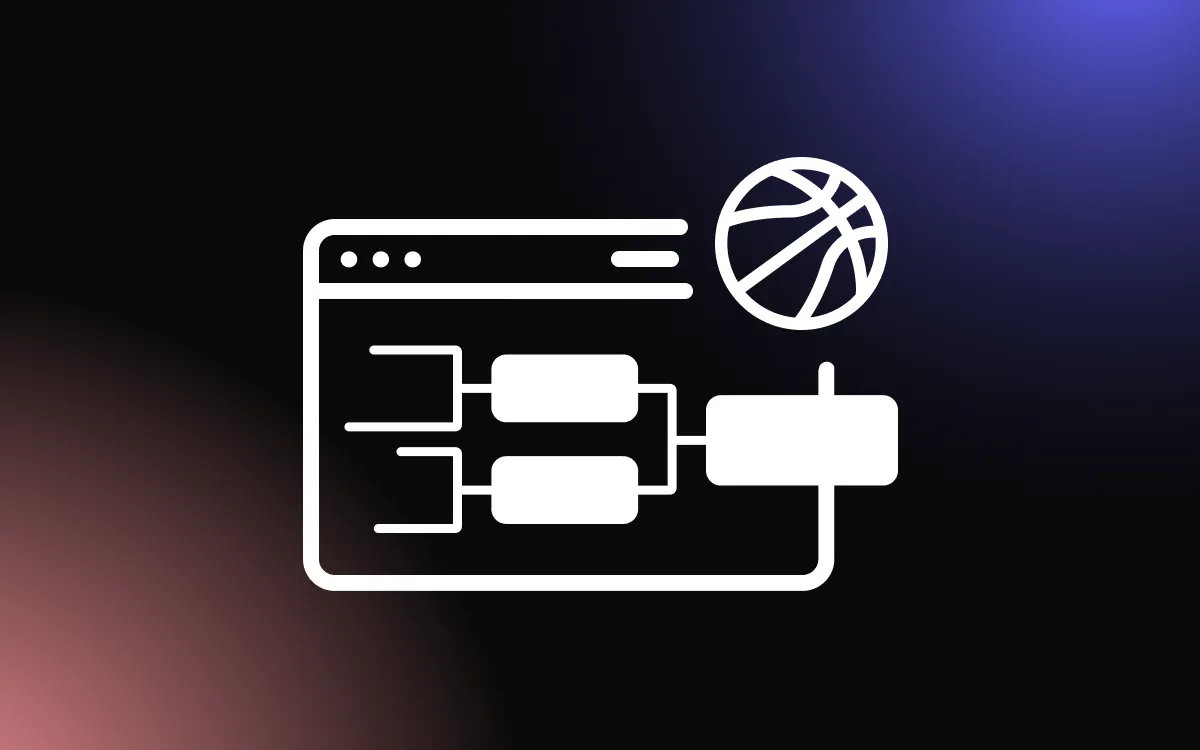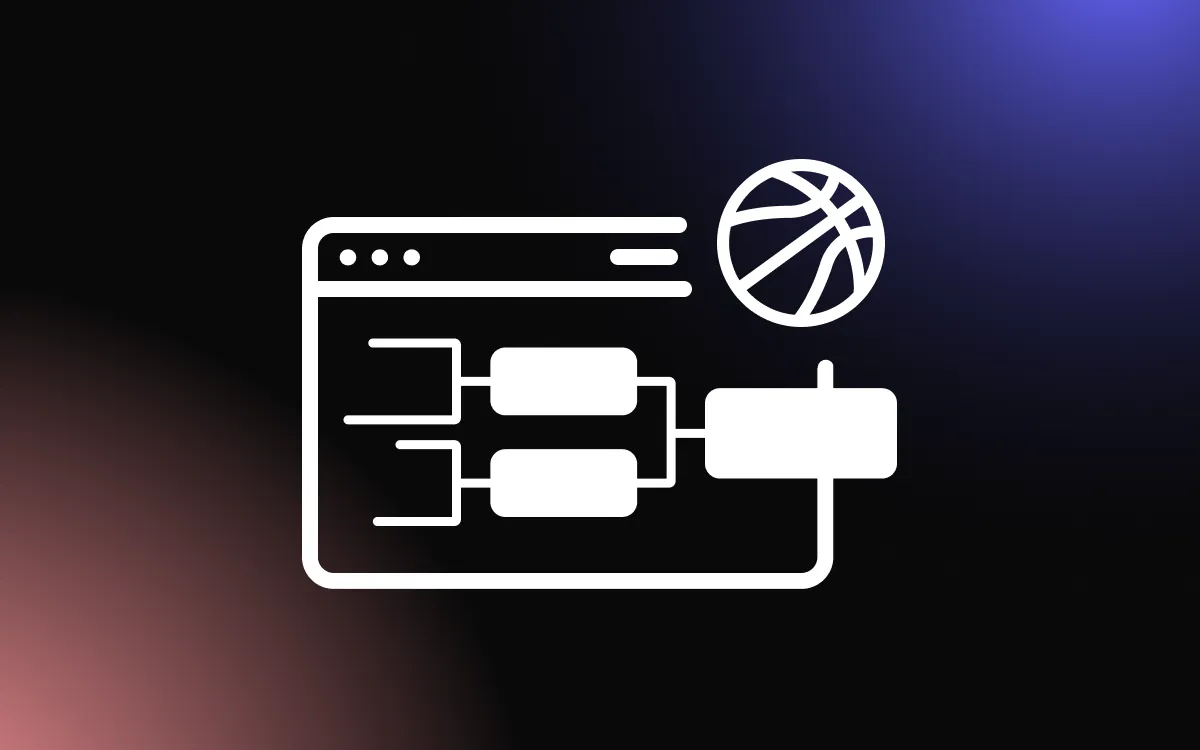Summary (TL;DR): In this article, we explore March Madness, focusing on the tournament's structure, the art of bracketology, and strategies for predicting outcomes. We discuss the psychological and economic impacts of the event, highlighting memorable games and the role of technology in bracket predictions. The piece concludes with a look at emerging trends and future innovations in college basketball and bracket analysis.

March Madness, the annual NCAA college basketball tournament, captivates millions with its thrilling upsets, buzzer-beaters, and the sheer unpredictability of each game.
Central to this frenzy is the tournament's bracket, a simple yet profound structure that maps the journey of 68 teams vying for the national championship.
This article takes a deep dive into the intricacies of March Madness brackets, exploring their history, structure, and the strategies fans use to predict winners. From the selection process to the final championship game, we'll uncover the layers that make these brackets much more than just a chart, but a cultural phenomenon.
Understanding March Madness: The Basics
The Tournament Structure
March Madness, the colloquial name for the NCAA Men's Basketball Tournament, is an annual sports extravaganza that captivates basketball fans across the United States.
Structured as a single-elimination tournament, it features 68 college basketball teams from the Division I level of the National Collegiate Athletic Association (NCAA), battling it out to become the national champion.
The tournament kicks off with the "First Four," where the lowest-ranked teams compete for a spot in the main bracket of 64 teams. From there, it progresses through several rounds: the Round of 64, Round of 32, Sweet Sixteen, Elite Eight, Final Four, and ultimately, the Championship Game.
Each round whittles down the competitors through intense matchups, leading to the much-anticipated final showdown.
Key Rules and Regulations
The rules and regulations of March Madness largely follow standard NCAA men's basketball rules. However, specific aspects are unique to the tournament:
- Selection and Seeding: Teams are selected and seeded based on their performance during the regular season and conference tournaments. The Selection Committee, comprising various university athletic directors and conference commissioners, is responsible for this process.
- Game Locations: Unlike regular-season games, tournament games are played at neutral sites, chosen in advance by the NCAA, to minimize home-court advantage.
- Overtime Rules: If a game is tied at the end of regulation, it goes into a five-minute overtime period. This process is repeated until a winner emerges.
- Player Eligibility: Players must be amateurs and meet NCAA eligibility requirements regarding academic performance and years of play.
The Art of Bracketology
Analyzing Team Statistics
Bracketology, the science (and art) of predicting the outcomes of tournament brackets, particularly in March Madness, starts with a deep dive into team statistics. This analysis isn't just about who won or lost; it's about understanding how and why teams win.
Key statistics include offensive and defensive efficiency, tempo, rebounding margins, and turnover rates. Advanced metrics like KenPom ratings, which combine various statistical factors to rank teams' performances, can also provide insights.
Evaluating these statistics helps in predicting how teams might perform under the unique pressures of the tournament.
Understanding Seeding and Match-Ups
Seeding is a crucial component of bracketology. The NCAA tournament committee assigns each team a seed, ranging from 1 to 16 in four different regions, based on their regular-season and conference tournament performances.
Generally, higher-seeded teams are stronger than lower-seeded ones. However, upsets are a hallmark of March Madness. Understanding the dynamics of each match-up is key.
For instance, a team's style of play might make them particularly well-suited to challenge a higher-seeded team. Historical trends can also be informative; for example, a 12-seed upsetting a 5-seed is a common occurrence.
Bracketologists often look for such potential upsets when filling out their brackets, considering factors like experience, coaching, depth, and even geographical advantages.
Strategies for Bracket Success
Predicting Upsets
One of the most thrilling aspects of March Madness is the potential for upsets, where lower-seeded teams triumph over their higher-seeded opponents. Predicting these upsets is both an art and a science.
Historically, certain seed matchups, like the 12-seed versus the 5-seed, have been more prone to upsets. To spot potential upsets, look at factors such as a team's performance in close games, their ability to win away from home, and their overall momentum entering the tournament.
Teams with strong defense, experienced coaches, and a history of performing under pressure can often defy expectations.
Expert Tips and Techniques
Experts often have a variety of techniques and strategies for bracket success. Some common tips include:
- Look Beyond the Seed: While seeding provides a general guideline, it's not infallible. Delve into how teams have performed against top competition and their ability to adapt to different styles of play.
- Regional Advantages: Teams playing closer to home or in familiar settings might have a slight edge.
- Coaching Experience: Coaches with a history of tournament success often know how to prepare their teams for the pressures of March Madness.
- Defensive Prowess: Teams that excel in defense tend to do well in the tournament, as they can control the game's pace and handle high-pressure situations.
- Health and Momentum: A team entering the tournament on a winning streak or regaining key players from injury can be primed for a deep run.
The Psychology Behind Bracket Picks
Emotional Decision Making
Bracket selections in March Madness often go beyond mere statistical analysis and enter the realm of emotional decision-making. Fans frequently pick teams based on personal connections, memorable past performances, or simply because they like a team's mascot or colors.
This emotional aspect can lead to surprising choices, often defying logical predictions based on performance metrics. The excitement and unpredictability of the tournament fuel these emotional decisions, making the event not just a sports competition but a personal journey for many fans.
The Role of Bias and Fandom
Bias and fandom play significant roles in how brackets are filled out. Loyalty to alma maters, hometown teams, or favorite players can heavily influence picks. This bias can sometimes cloud judgment, leading to overconfidence in a favored team's abilities or chances.
On the flip side, rivalries and negative experiences with certain teams can lead to underestimating their potential. Understanding and acknowledging these biases can be crucial for fans looking to make more objective, and potentially successful, bracket choices.
However, for many, the joy of March Madness lies not in perfect accuracy, but in the passionate support and hope for their beloved teams.
The Economic Impact of March Madness
Betting and Financial Implications
March Madness is not just a major sports event; it's also a significant economic driver, particularly in the betting industry. From office pools to online betting platforms, millions of dollars are wagered on the outcomes of the games.
This betting frenzy extends beyond just picking winners, encompassing various aspects of the games such as point spreads, player performances, and even minute details like the first team to score.
The financial implications are vast, with the American Gaming Association estimating that billions are bet annually on March Madness alone. This betting culture not only fuels the excitement around the tournament but also impacts the economy, with ripple effects across different sectors.
Advertising and Sponsorships
March Madness is a goldmine for advertisers and sponsors. The tournament's wide viewership provides a massive platform for brands to showcase their products and services. Major companies vie for advertising spots during game broadcasts, and the rates for these spots can be astronomical due to the high demand.
Sponsorship deals are also crucial, with NCAA partners and sponsors gaining exclusive rights to use NCAA logos and marks in their promotions, enhancing brand visibility and association with the excitement of college basketball.
The influx of advertising and sponsorship money not only boosts the NCAA's revenues but also significantly impacts media and marketing industries, contributing to the overall economic significance of the event.
Leveraging Technology in Brackets
The Best Tool for Creating March Madness Brackets

For those looking to create March Madness brackets, the Free Bracket Maker by Common Ninja is an outstanding choice. This tool is specifically tailored to handle the excitement and complexity of March Madness tournaments. It offers a user-friendly interface that simplifies the process of setting up brackets, even for those with no prior experience.
Users can easily input teams, manage matchups, and update scores as the tournament progresses. The widget also allows for customization, enabling users to personalize the look and feel of their brackets to match their website or personal style.
Additionally, the Free Bracket Maker supports various bracket formats and includes features like real-time updates and interactive elements to engage viewers. Whether you're a seasoned tournament organizer or a casual fan looking to create a bracket for fun, this tool provides all the necessary functionalities to make your March Madness experience seamless and enjoyable.
Data Analytics in Predicting Outcomes
Data analytics plays a crucial role in enhancing the bracket experience by predicting outcomes with greater accuracy. Advanced algorithms analyze vast amounts of data, including team statistics, player performance, historical trends, and even real-time game developments, to forecast match results.
This analytical approach helps in making informed decisions while filling out brackets, especially in identifying potential upsets and understanding team dynamics. For enthusiasts and bettors, these insights are invaluable in increasing their chances of success.
Moreover, machine learning models continue to evolve, constantly improving their predictive capabilities, thereby making the process of bracket prediction more sophisticated and data-driven.
Memorable March Madness Moments
Historic Games and Performances
March Madness has been a stage for some of the most historic games and performances in college basketball history. These moments are etched in the memories of fans and have shaped the legacy of the tournament.
From buzzer-beaters to record-breaking individual performances, these games exemplify the high stakes and dramatic nature of the tournament. Legendary games, like the Duke-Kentucky East Regional Final in 1992, known for Christian Laettner's iconic game-winning shot, or Kris Jenkins' buzzer-beater for Villanova to win the 2016 National Championship, are prime examples.
Such performances not only define players' careers but also symbolize the essence of March Madness — where heroes are made, and legends are born.
Cinderella Stories and Major Upsets
March Madness is renowned for its "Cinderella stories" — where lower-seeded teams defy the odds and advance further than expected. These underdog stories often capture the hearts of fans and become a defining feature of the tournament.
Major upsets, such as the shocking victory of 16-seed UMBC over top-seeded Virginia in 2018, the first time in history a 16-seed defeated a 1-seed, are what make the tournament unpredictable and thrilling.
Other memorable Cinderella teams include George Mason's run to the Final Four in 2006, and Loyola Chicago's similar journey in 2018. These upsets and underdog stories not only create an electrifying atmosphere but also remind us that in March Madness, anything is possible.
Hosting a March Madness Bracket Challenge
Organizing and Managing Pools
Hosting a March Madness bracket challenge involves meticulous organization and effective management. The key is to set up a clear, accessible platform where participants can fill out their brackets and track progress.
This can be done through various online bracket tools or websites dedicated to March Madness pools. It's crucial to establish the rules upfront, including scoring systems (e.g., points per round, bonus for upsets) and deadlines for submissions.
Effective communication is essential, ensuring all participants are aware of the rules, timelines, and any updates throughout the tournament. Additionally, consider tools that automate score tracking and updates, reducing the administrative burden and enhancing the experience for everyone involved.
Engaging Participants
To keep participants engaged in the bracket challenge, consider incorporating interactive elements such as live leaderboards, discussion forums, or social media groups. These platforms can foster a sense of community and competition, encouraging participants to stay involved throughout the tournament.
Offering prizes or incentives can also heighten interest and participation. These could range from monetary rewards to simple acknowledgments like a trophy or a feature on a website or newsletter. Remember, the goal is to create an enjoyable and memorable experience that encourages participants to return year after year.
The Future of March Madness and Bracketology
Emerging Trends in College Basketball
The landscape of college basketball is continually evolving, with new trends shaping the future of the sport and, by extension, March Madness. These trends include changes in player recruitment and development, with a growing focus on international talent and advanced training techniques.
The increasing use of analytics in strategy and player performance evaluation is also notable. Additionally, there's a shift towards more dynamic, fast-paced playing styles, influenced by professional leagues.
These changes not only affect how teams are formed and games are played but also how fans and analysts approach March Madness predictions and strategies.
Innovations in Bracket Prediction and Analysis
Bracketology, the art of predicting the outcomes of March Madness games, is witnessing significant innovations, particularly in the realm of technology and data analysis. Machine learning algorithms and predictive models are becoming more sophisticated, offering deeper insights into team performance and potential upsets.
Social media and big data are also playing a larger role, providing real-time analytics and public sentiment analysis.
Furthermore, virtual and augmented reality technologies are beginning to offer immersive ways to experience games and analyze data, potentially transforming how fans and experts engage with March Madness in the future. These advancements promise to make bracket predictions more accurate, insightful, and engaging, heralding a new era in the beloved tournament.
Conclusion
The March Madness bracket is more than just a tool for tracking basketball games; it's a symbol of hope, excitement, and the unpredictable nature of sports. As we've explored, the bracket's structure, while straightforward, hosts a complex array of stories, strategies, and statistics that make the NCAA tournament one of the most exciting events in sports.
Whether you're a die-hard fan, a casual observer, or a statistics enthusiast, the March Madness bracket offers something for everyone. Its ability to bring people together, challenge the odds, and create unforgettable moments is what makes diving into its depths so rewarding.
As another tournament concludes, we're reminded that in the world of March Madness, anything can happen, and that's what makes every bracket filled out, every game watched, and every moment cherished, a part of something truly special.


